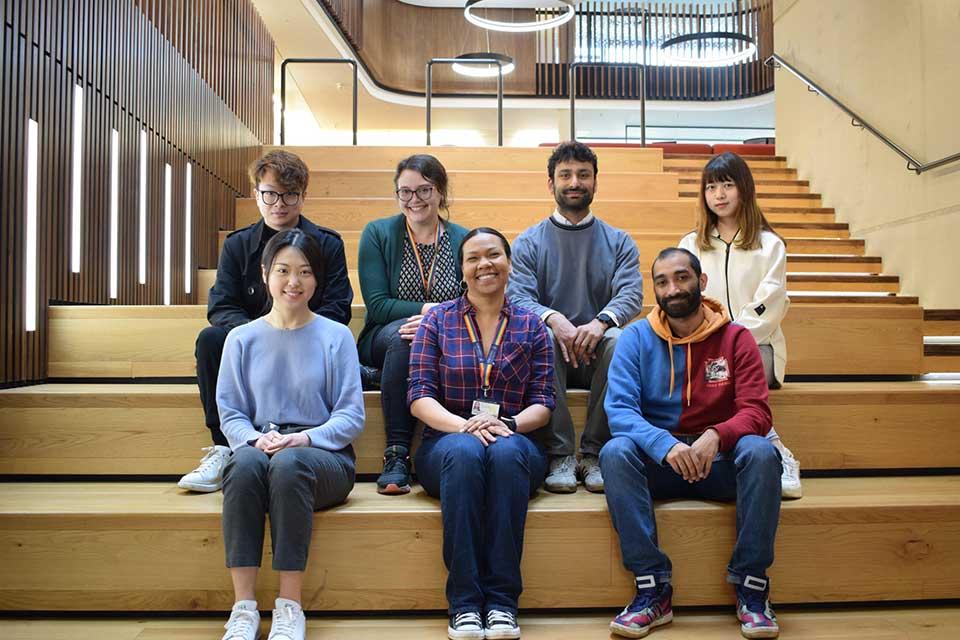Dr Nakita Noel is an EPSRC Research Fellow at the Department of Physics. Her work is generating new insights into perovskites to accelerate the development of high-performance perovskite solar cells and LEDs.
Today, Dr Noel’s research is inextricably linked with Oxford; having studied for her DPhil here in 2011 followed by taking up a postdoctoral role, she is now over halfway through her EPSRC fellowship in the Department of Physics. She works alongside colleagues she regards almost as family. But it so nearly didn’t happen that way…
Nakita’s area of interest is in semiconductor materials – with a purpose. Her research sits at the intersection of condensed matter physics, chemistry and materials science and her current focus is on understanding the fundamental processes governing thin-film crystallisation and defect formation in particular semiconductors – namely perovskites – driven by their potential for efficient solar power. Understanding how and why materials work in the way they do is critical to maximising their potential and that is what motivates Nakita.
A passion for science
Born and raised in Trinidad, she had a passion for science from a young age, largely inspired by her scientist older brother, 14 years her senior. She recalls how, at the age of seven, he had her reading a book on optics before the pair of them went outside with a magnifying glass to set some plants on fire. Always curious about the world around her, she ended up, perhaps unsurprisingly, taking physics, chemistry, biology and maths at A-level.
She went on to do her undergraduate studies at the University of the West Indies in Trinidad where she chose to double major in chemistry and physics. While it brought with it a significant workload, it also meant that she didn’t have to choose between her two great passions; chemistry that came to her so naturally and physics that challenged her to think differently.
A different perspective on new materials
Her double major meant her timetable was already full however she still managed to squeeze in electives – in spite of not even being able to declare them. She opted for modules in environmental science and materials chemistry, and her experience laid the foundations for steering the course of her future career. Her interest in materials, but coming at the subject as a physicist as much as a chemist, offered an interesting perspective. She was able to further explore this after graduating, when she worked for a year looking at semiconductor nanocrystals.
As an oil- and gas-rich island, the expected career trajectory for students like Nakita in Trinidad would be to go down the engineering route and do petroleum geoscience. But this wasn’t for Nakita. She grew up hearing her grandmother – and even her mother – recall how they had not known such heat when they were growing up, and this first-hand experience of climate change drove Nakita to want to focus her research on alternative energy sources and materials.
Photovoltaics and semiconductors
It was when she was considering her next steps that DPhil study at Oxford unexpectedly became an option. She had been looking at studying for a PhD in Canada and had offers from UCL and Imperial to do her Masters in Physics, when a very good friend begged her to consider Oxford; he wanted to apply and didn’t want to relocate from Trinidad to Oxford by himself and so persuaded Nakita to apply too. Not expecting anything from it, she applied to do a DPhil in Condensed Matter Physics with particular interest in photovoltaics and semiconductors. Much to her surprise, she was offered a place and, while her friend decided to stay in Trinidad, in 2011, she found herself in Oxford embarking upon a 3-year DPhil working in Professor Henry Snaith’s group.
Working as part of Professor Snaith’s group – firstly as a DPhil student and then taking up a postdoctoral position – gave her the flexibility of being able to follow her own line of enquiry while knowing she had the support of her supervisor and colleagues when needed. She found her niche in ‘translating’ between the physicists and the chemists in understanding why materials work in the way that they do. Right now, she is focused on perovskites but it’s a principle that she can translate to any material system.
Oxford calling
There followed a stint at Princeton University in the United States before Nakita once again found herself faced with a decision to make: to take up the sought-after tenure-track offer in the States or to return to Oxford to pursue her research with her equally sought-after EPSRC research fellowship. Instead of being driven by the material, she asked herself where she would best be able to do the things she wanted to do. Where was her new interpretation of ‘home’? For Nakita, that was Oxford and she is now halfway through her fellowship, working at the heart of Oxford’s world-leading semiconductor research community.
For Nakita, being a scientist is about solving puzzles – but with the purpose of helping humanity. Her work today – exploring perovskites as a sustainable alternative energy source that harnesses the power of the sun – is driven in no small part by having grown up on a small Caribbean island that would be the first to feel the devastating effects of climate change. She values the human connections that being a scientist affords; while great science can be done anywhere and by any one scientist, she values the community aspect of science and working alongside those who inspire, motivate and question her, making her the best she can be. She is deathly afraid of being bored – but, working in her chosen field at such a critical juncture for humanity, there is little danger of that.


